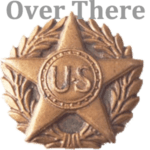 A series profiling American Jewish service in the First World War
A series profiling American Jewish service in the First World War
Zadoc Morton Katz
Baltimore Boy Killed in Action at Montfaucon
The U.S. had entered the Great War. Friends of Zadoc Morton Katz suggested his education and training as an executive in the clothing industry might make him well-suited to contribute to the war effort by getting a government job in Washington. He’d graduated from Baltimore City College at age 16 and joined his father’s firm where he became a partner at age 21. Along with his commercial success, Katz had continued his education at Johns Hopkins University. But now, the war was on. Katz was indignant at the thought of taking an office job. He refused to be what he called a “swivel-chair patriot.” The Baltimore-native entered the Army requesting early entry after he was drafted. He trained at Camp Meade beginning May 28, 1918. On July 6th, 1918, Private Katz sailed for Europe as a member of Company I, 313th Infantry, “Baltimore’s Own” aboard the USS Leviathan. The ship anchored in the harbor of Brest, France nine days later.
In A Tribute to the Baltimore Jewish Boys Who Participated in the Great War, The Jewish Times reported on his life based on a series of letters written home to his parents. They described some of his activities overseas. After his arrival in Europe, Katz was billeted with his company in a small town France. Katz was able to use his French language skills to act as an interpreter. He studied signaling and information gathering techniques at a divisional intelligence school. His regiment was attached to battalion headquarters where he manned observation posts. On September 11, just 16 days prior to his death, Katz had written home describing a Rosh Hashanah service he attended:
I don’t think any of the 250 Jewish boys assembled in the “Y” hut last Saturday morning to celebrate ‘Rosh Hashona’ could have been more profoundly moved than I. With no one to officiate but the boys themselves, and no complete prayer book of the service, the orthodox service was chanted through; and then for the benefit of those who do not know Hebrew, a great part of the service was given in English. You should have heard the ‘En Kelohenu’, also the ‘Adon Olom’. Except for the small coterie with whom I was, most of the boys are Russian Jews; they are thorough soldiers and we will have no reason to be ashamed of them. The services concluded about 11 A. M. with the singing of ‘America’, and I reported to my platoon for duty, feeling a pride in my co-religionists and a surety that after the war the epithet ‘Coward’ cannot be hurled at us.
The 313th Infantry played a key role at in the Meuse-Argonne Offensive. They were expected to clear over 4 miles of enemy territory and take the heights of Mountfacon which the Germans were using to observe American positions. On September 25th, the first night of the attack on Montfaucon, Katz lay in a trench with rain and enemy fire falling all around him. A comrade had lost all of his rations and water, Katz shared his reserve rations, and spread out his overcoat so that it covered both of them.

On September 27th, they entered the town of Montfaucon. The Times described Katz’s experience:
At about 5 P. M., observing that the regiment on his left (from another division) had stopped and his own regiment, which had continued to advance, was being fired upon from the woods on their left front. Katz cried to his companion: “We have to do something; they need more troops out there. We came over to get into this; so let’s go where we are needed most.” They found an officer who had troops in reserve, explained the situation to him, set out with about 40 men in two detachments and led them to another officer who was in command where the men were needed. Later on, for rest and protection, they spread themselves flat upon the hillside, facing the enemy about 20 yards from the most advanced lines. Here Katz was shot.
A letter from a comrade of Katz to his parents described his heroism: “I think it will be of interest to you to know that Morton met his end immediately after accomplishing a heroic deed, which probably saved many boys’ lives, and in passing away suffered no pain; and in conclusion I want to say that the upright boy had lots of friends and gave his life like many others for a good cause.”
His death was instantaneous. Katz was one of over 1,200 men in the regiment killed during the battle where the Americans successfully captured Montfaucon. Katz was buried at Meuse-Argonne American Cemetery and Memorial in Romagne-sous-Montfaucon, France. There were many tributes to Katz in Baltimore including poems about his sacrifice. Scholarships were established in his name. In his will, Katz himself had left money to Baltimore charities. He was hailed as a hero and a man whose sacrificed helped achieve the ideals in which he believe.